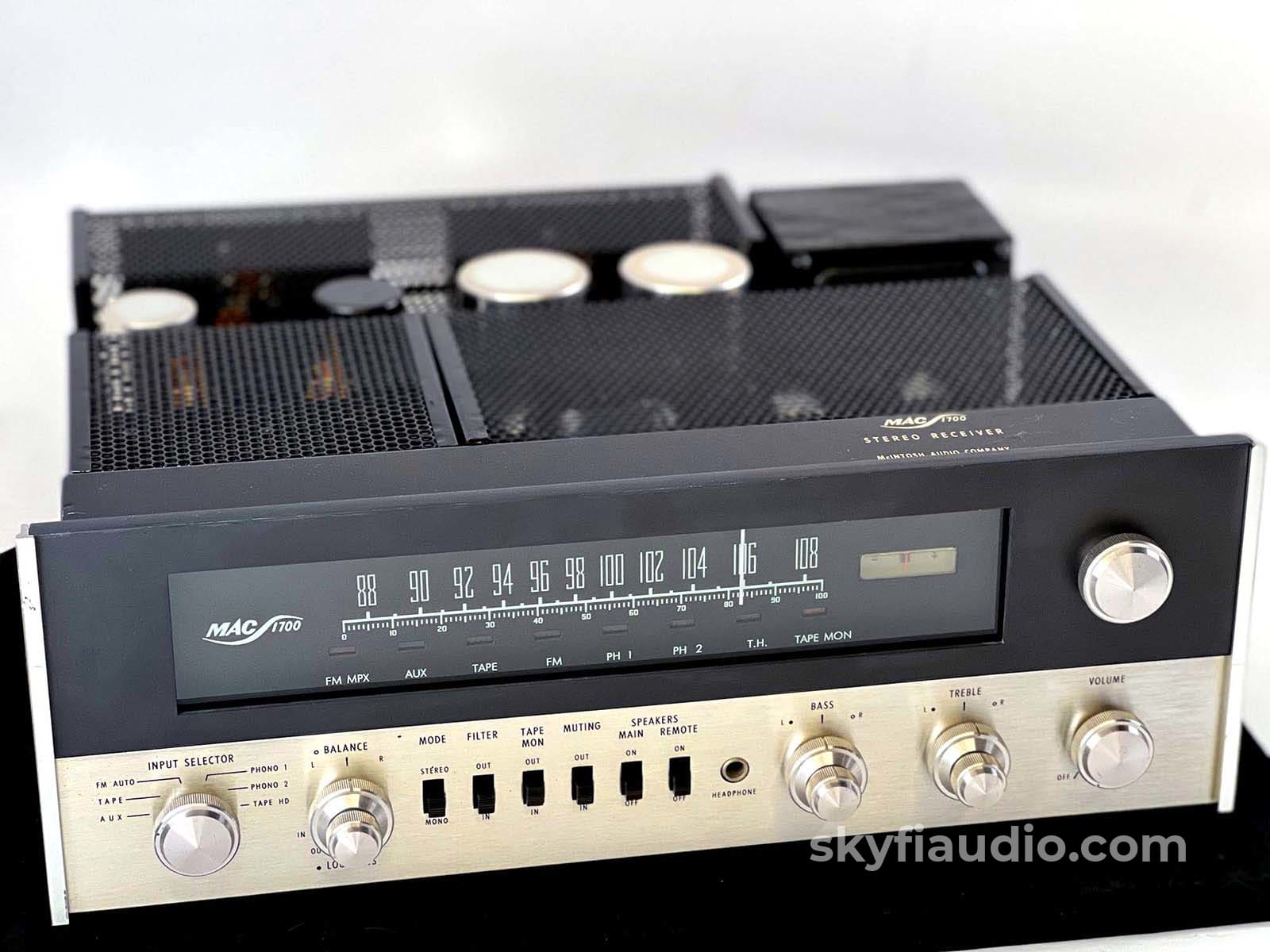
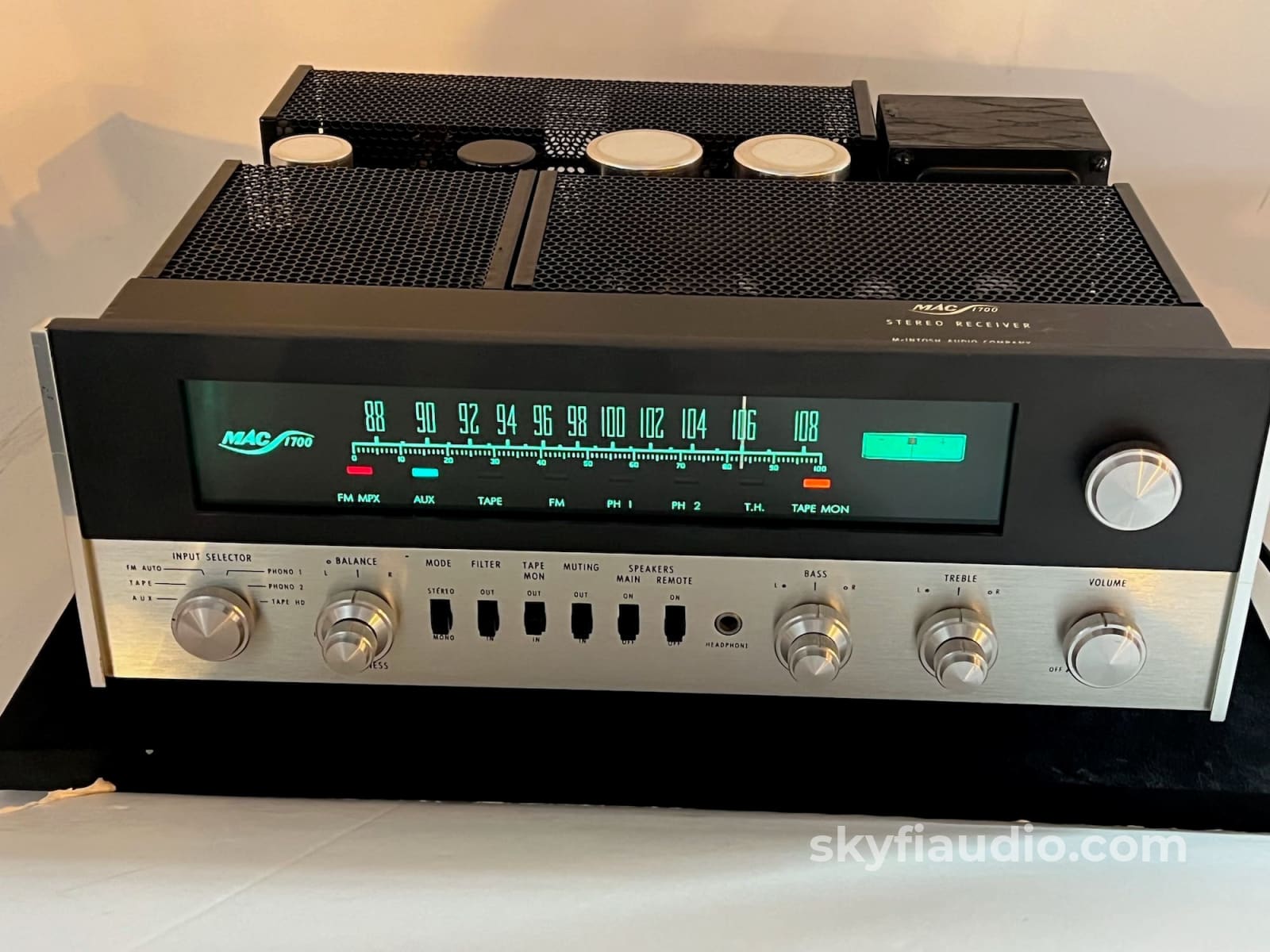

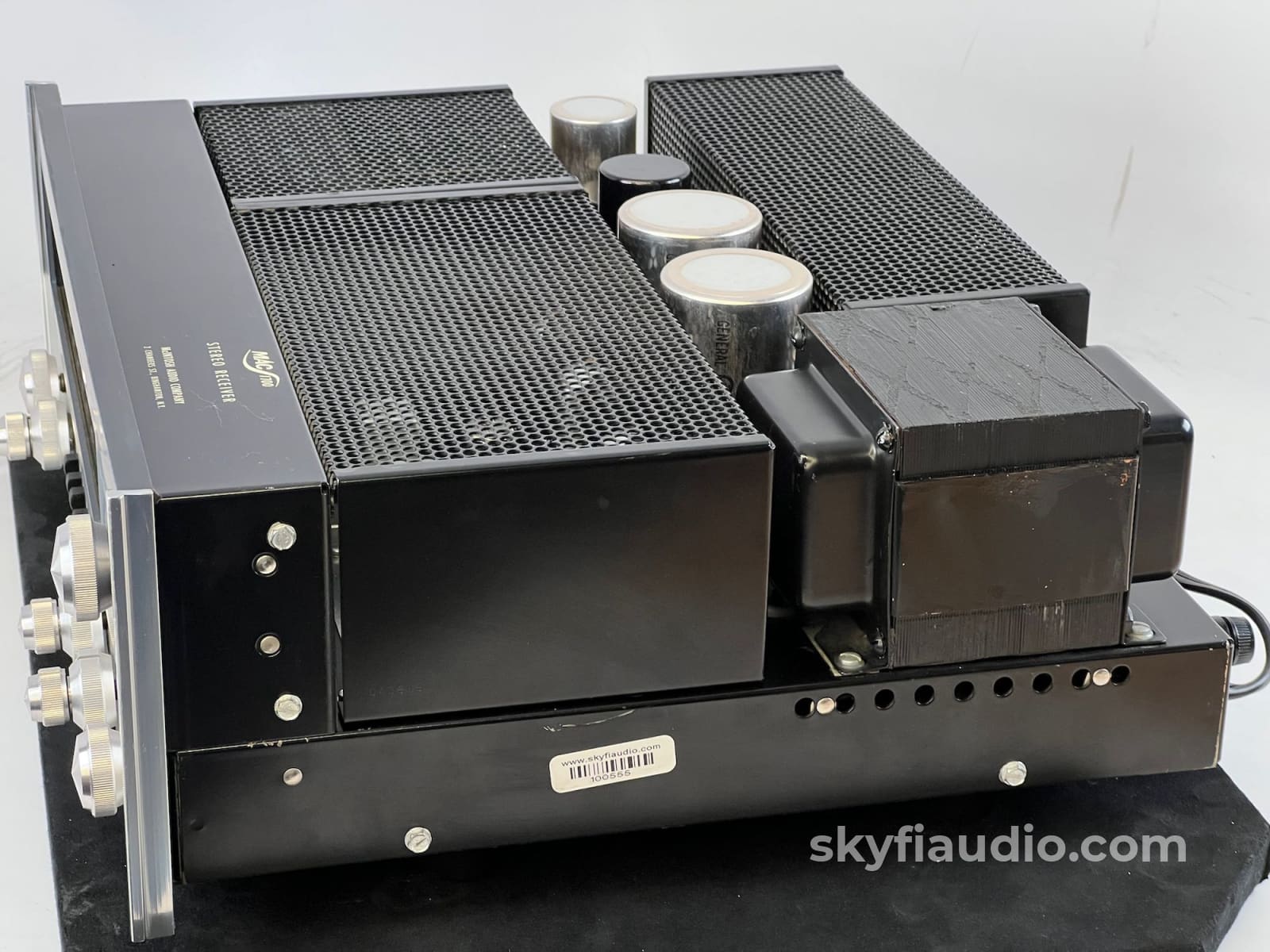
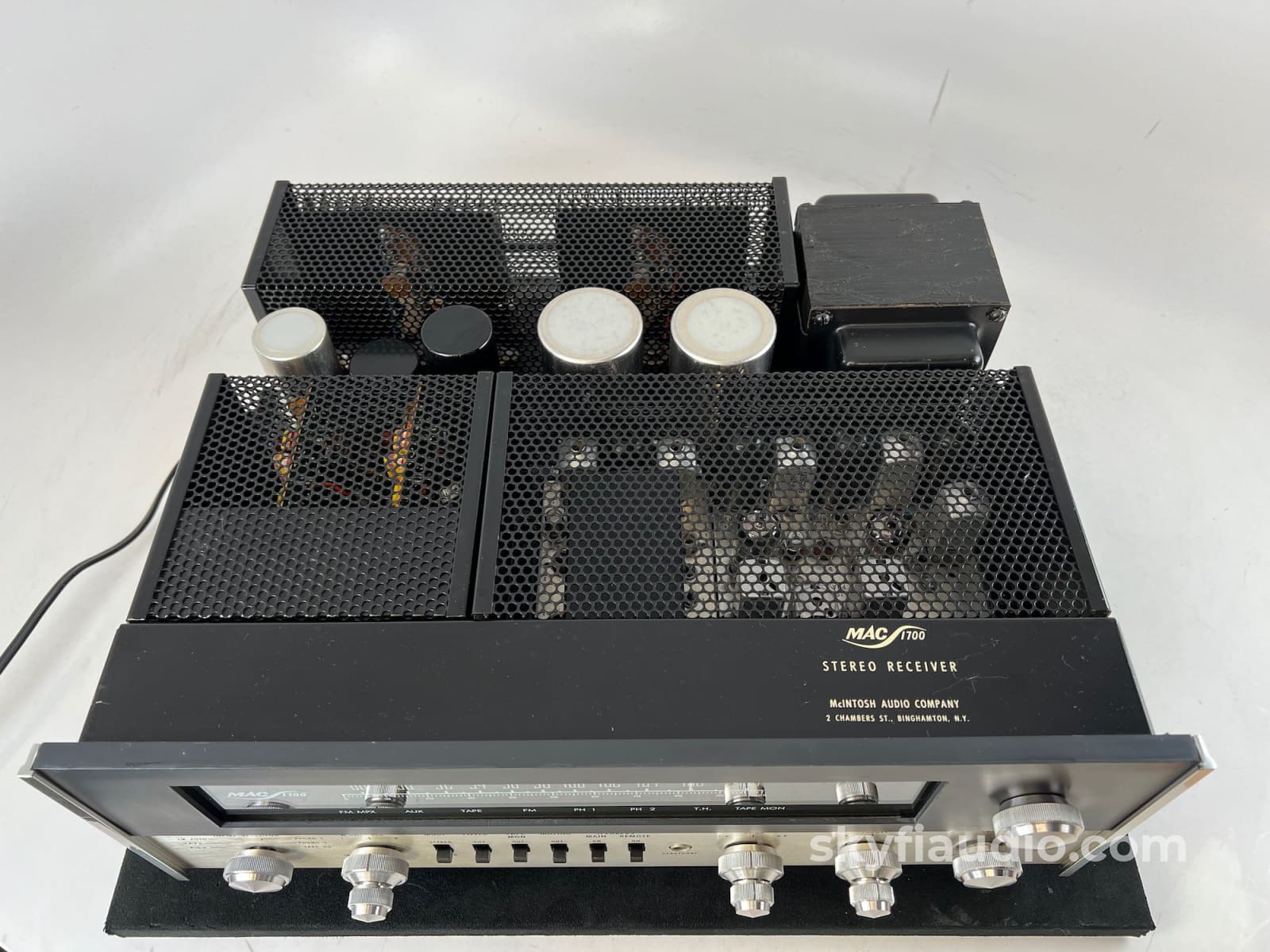
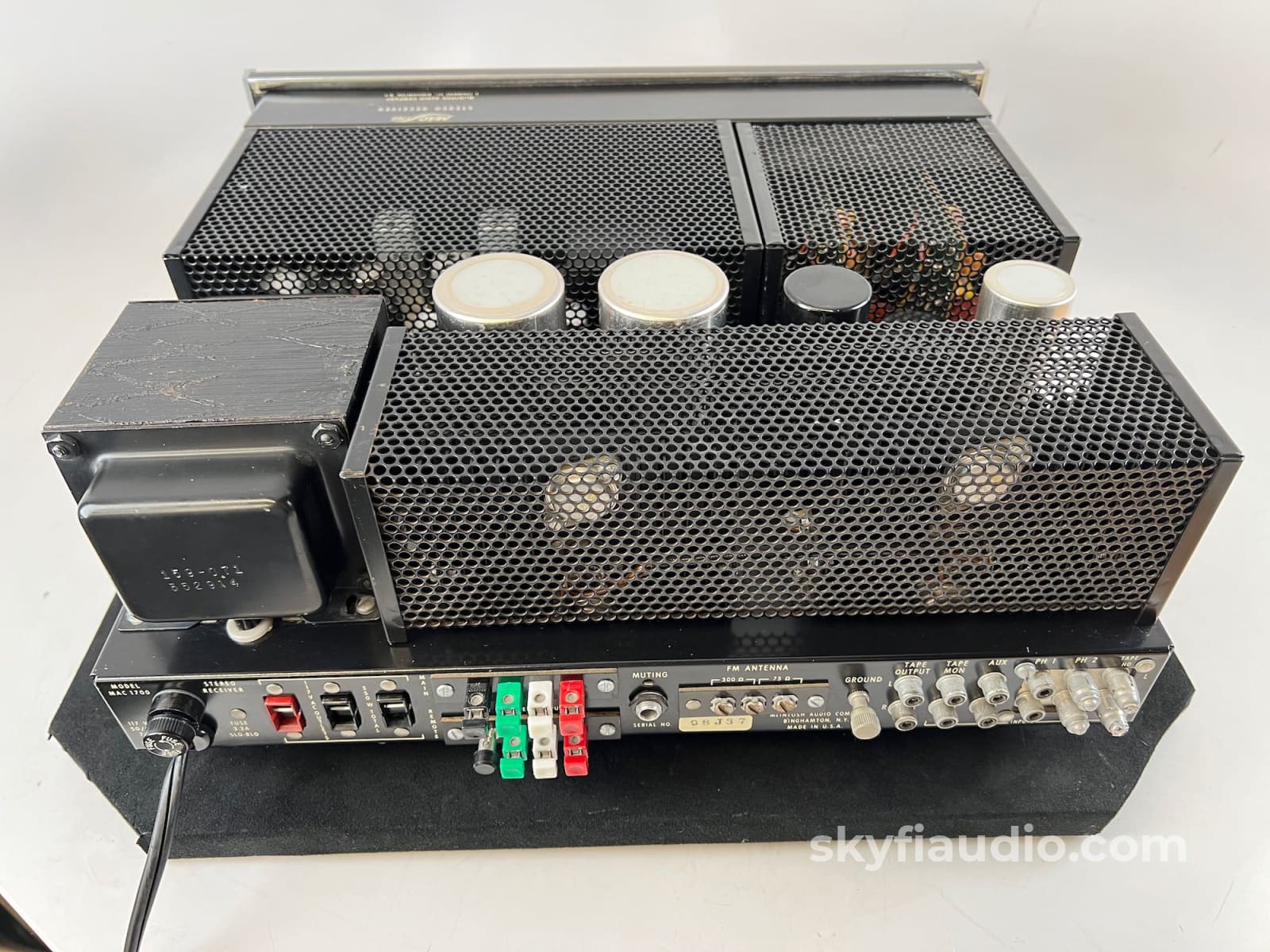
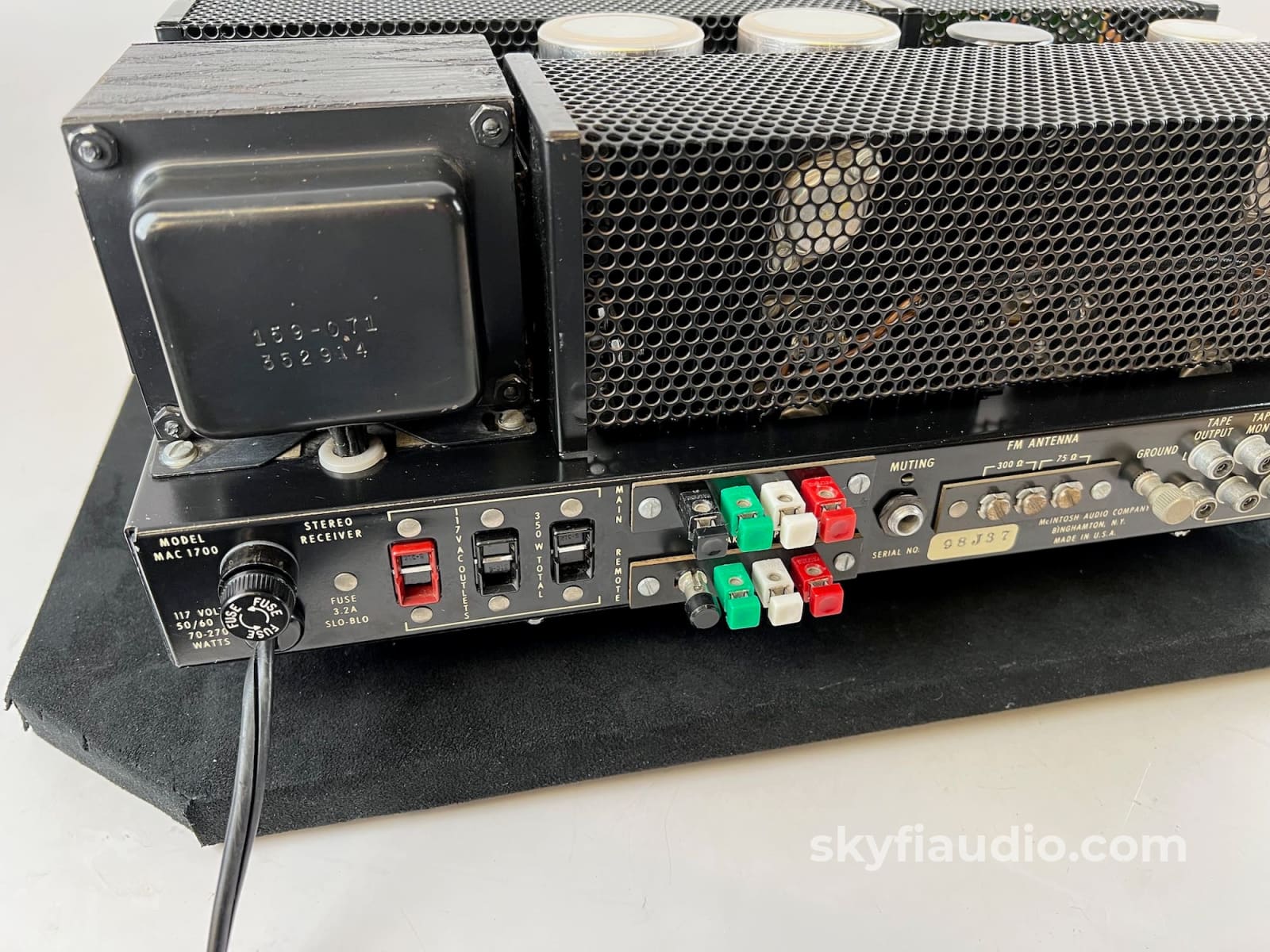
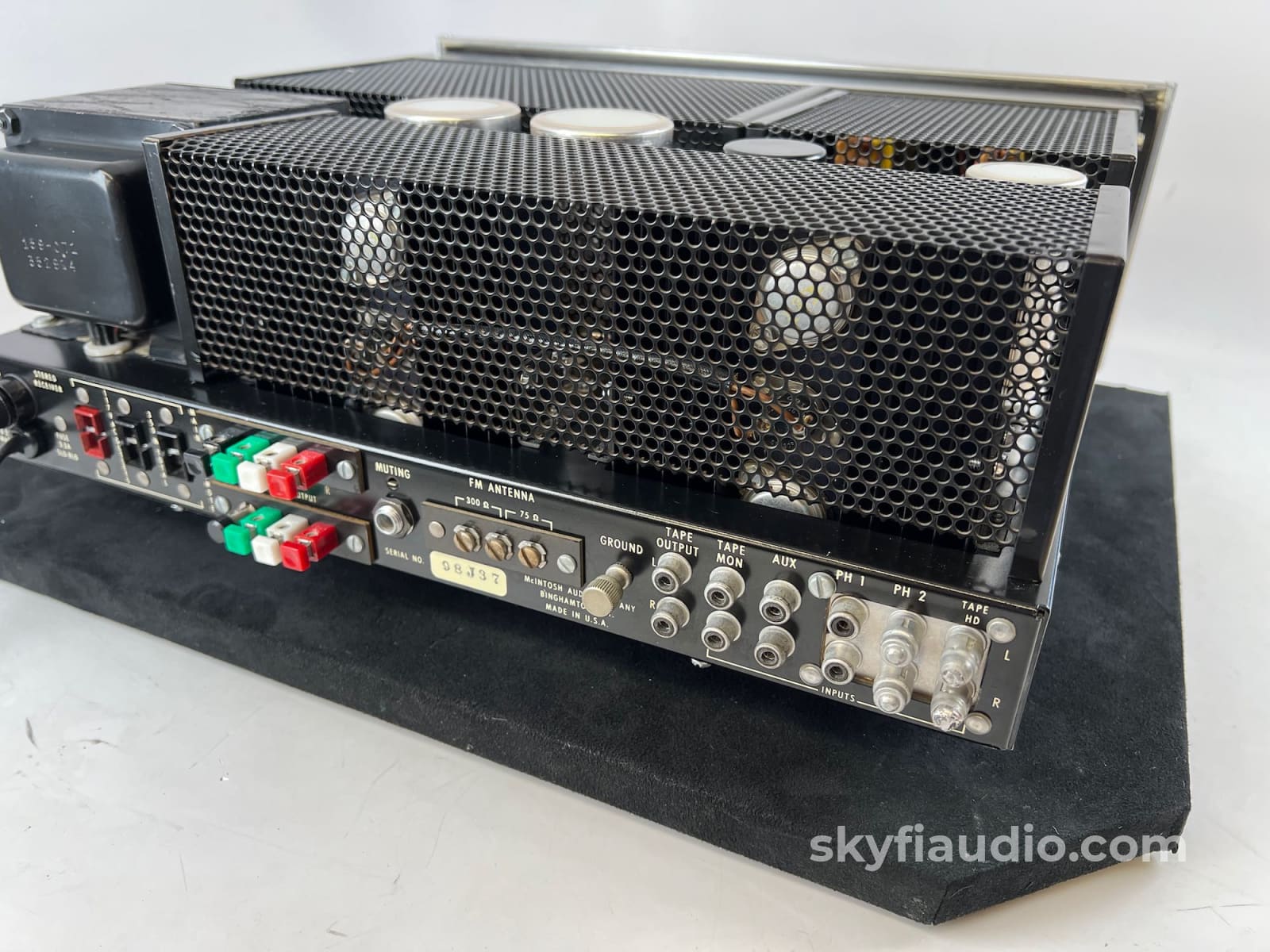
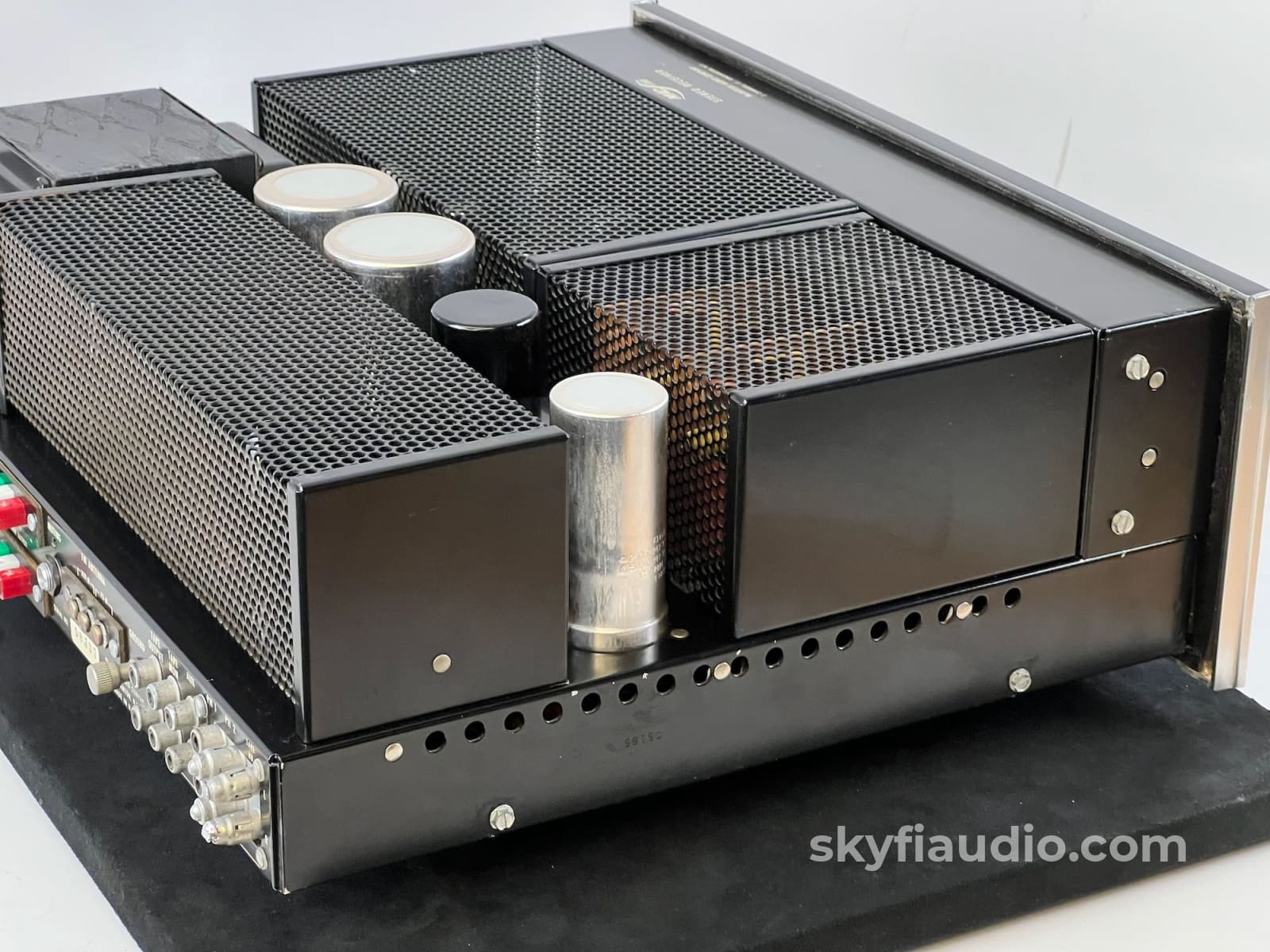

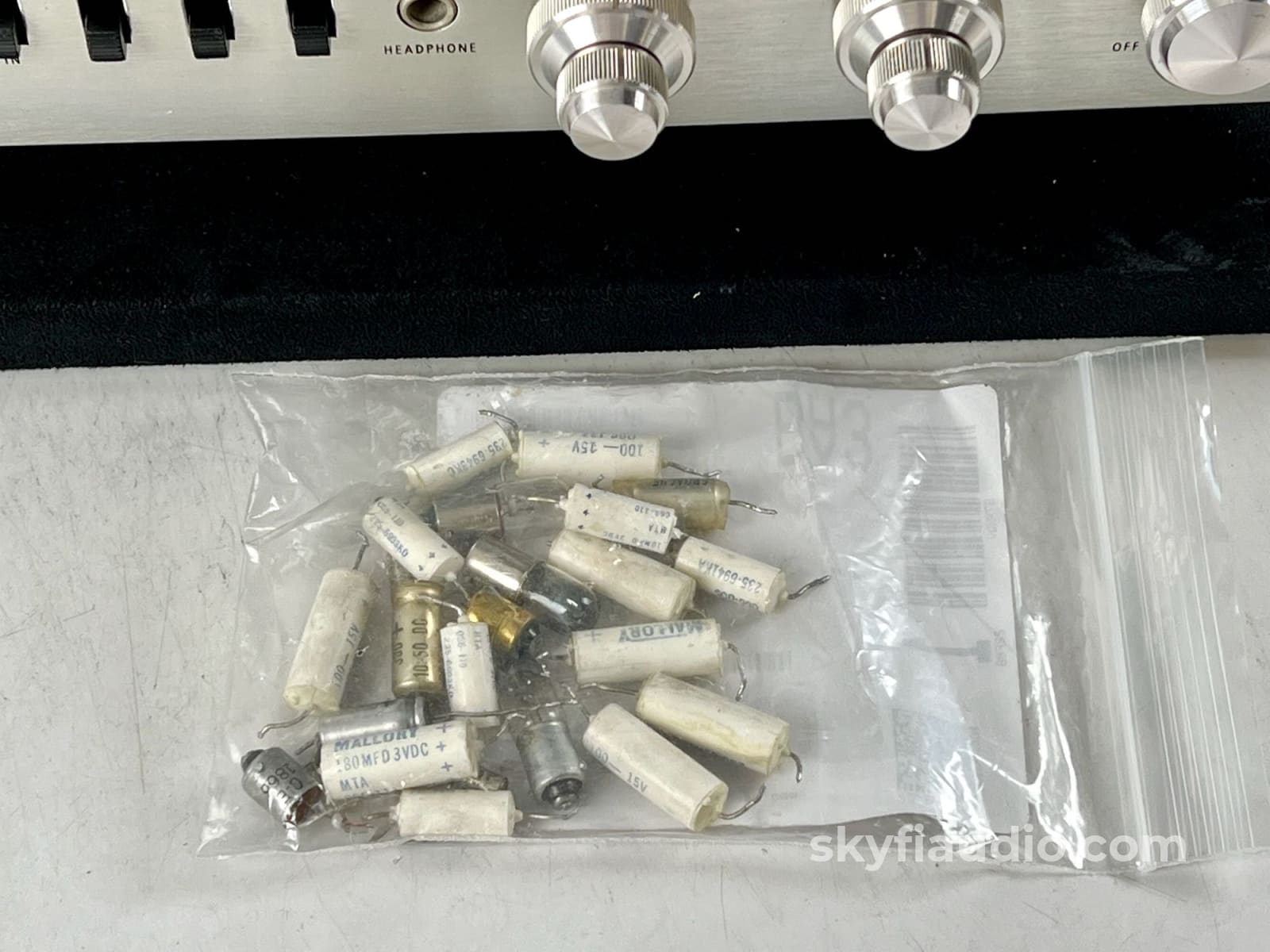
McIntosh MAC1700 Vintage Receiver w/Tube Tuner - Serviced
Free Shipping on Most Electronics - Excludes Speakers and Items Requiring Freight - Contiguous U.S. Only
Pickup currently unavailable at SkyFi 479

McIntosh MAC1700 Vintage Receiver w/Tube Tuner - Serviced
SkyFi 479
479 South Broad Street
Glen Rock NJ 07452
United States
This is a hybrid model receiver from McIntosh comprised of a solid state amplifier and tube tuner section. Installed tubes are 2 x 6DS4, 2 x 6HS6, 6AU6A, 6CS6, 6EA8, and finally 12AU7. Each tube was carefully reviewed and tested with our modern calibrated & professional tube testing equipment.
It was produced from 1967-1973 with an original retail price of $599.00. That works out to $5,100+ in today's dollars!
The MAC1700 is a full featured receiver that's perfect for a starter McIntosh System or your office.
We rarely receive MAC1700's into our shop and our best guess as to why is because their owners don't want to part with them.
This example is one of the few and definitely one of the best looking 1700's we've ever seen. The Faceplate is excellent and all of the knobs are shiny and pristine. There are no sigs of rust or corrosion anywhere. The front faceplate glass was professionally replaced and is like new.
It's finished in a gorgeous champagne colored front panel with aluminum knobs and glass.
Functions include: dual phono inputs, individual left and right tone controls for bass and treble, and convenience outlets for powering other devices.
Built like a tank and likely to outlive us all... Best of all it has the signature sweet McIntosh sound we've all come to love.
SkyFi Service Notes:
• Replaced front dial glass.
• Replaced all out of manufacturer spec axial capacitors.
• Replaced lamps.
• Checked all remaining capacitors in spec.
• Tuner alignment to correct dial tracking.
• Tested to 50W per channel with equal clipping.
• Long term testing PASS.
These older McIntosh units experience some minor channel imbalance in the volume controls.
This is caused by a couple of age related factors, the most significant being a small amount of physical play in the shaft that turns the controls themselves. This causes slight channel imbalance on the way up as the volume is increased.
The difference is minimized when the control is turned in the counterclockwise direction. Audibly, this translates to one channel seeming to come in before the other when first rotating the control and a slight shift in the stereo image depending on the position of the control.
This of course can be corrected with some minor manual tweaking of the balance control (up and down). The issue is most prevalent at low listening levels. We checked with McIntosh and a replacement volume control is long discontinued.
These older McIntosh units experience some minor channel imbalance in the volume controls.
This is caused by a couple of age related factors, the most significant being a small amount of physical play in the shaft that turns the controls themselves. This causes slight channel imbalance on the way up as the volume is increased.
The difference is minimized when the control is turned in the counterclockwise direction. Audibly, this translates to one channel seeming to come in before the other when first rotating the control and a slight shift in the stereo image depending on the position of the control.
This of course can be corrected with some minor manual tweaking of the balance control (up and down). The issue is most prevalent at low listening levels. We checked with McIntosh and a replacement volume control is long discontinued.
Click below to add our recommended matching cables from Kimber Kable, all brand new as SkyFi is an official Kimber dealer.
Kimber Kable - RCA Interconnects
Kimber Kable - Phono Interconnects
Specifications:
ELECTRICAL: Stereo. Hybrid (Solid state preamp and power amp, tube tuner). 40w/ch into 4 or 8 ohms. Response 20-20kHz (+0.5 -0.5dB). Distortion .25%. Noise and hum: power amp -90dB, aux -75dB, phono -76dB below 10 mV. Damping factor 100. Input impedance: aux 250k, phono 47k, tape head 500k. Input sensitivity: aux 0.3V, phono 2.4mV, tape head 2.4mV. Tone controls: bass and treble. +18 to -18dB. Filter: 60Hz at 12dB/octave and 5kHz at 12dB/octave.
FM SECTION: Sensitivity 2.5uV, S/N 65dB, Distortion 0.8% in stereo, Response 20-20kHz, Capture ratio 2.0dB. Image rejection 60dB, Stereo separation 30dB.
FRONT PANEL: Black and silver. Input selector: aux, tape, fm auto, phono 1, phono 2, tape hd. Balance. Slide switches: mode: stereo or mono, filter: out or in, tape mon: out or in, muting: out or in, loud: out or in, speaker: on or off. Headphone jack. Dual concentric bass and treble controls. Volume with power switch. Tuning knob. Tuning meter. Illuminated tuning dial. Indicator lights: fm mpx, aux, tape, fm, ph 1, ph 2, th, tape mon.
BACK PANEL: Barrier strip speaker terminals, Screw terminals: 300 ohm and 75 ohm antenna. Ground terminal. Inputs: tape mon, aux, ph 1, ph 2, tape hd. Tape out 1. Muting control. AC outlets: 2 switched, 1 unswitched. fuse.
TUBES: 2-6DS4, 2-6HS6, 6AU6A, 6CS6, 6EA8, 12AU7.
Size: 5-1/2"H, 16"W and 14-1/2"D. Weight 34 lb.
McIntosh MAC1700 Owner's Manual
The SkyFi Testing Process for Solid State Amplifiers:
We start with a visual inspection of all internal components to make sure that there are no signs of heat stress or damage. Capacitors are checked for telltale signs of predictive failure including bulging, shrunken wrappers, or physical leakage. We also inspect the PCBs for discoloration from resistors or transistors that may have been running hot. On vintage units we often spot check select capacitors for value and ESR.
If the amplifier passes visual inspection, we move on to a controlled power on sequence using a Sencore safety analyzer to monitor current draw in real time. Once the amplifier is determined to be safe to operate, we connect it to full AC mains for function and power testing. We connect the speaker outputs of the amplifier to a Sencore PA81 Power Analyzer which acts as a dummy load, DC offset monitor, and oscilloscope interface. We start with a low level 1KHz test signal at the amplifier’s input and slowly increase its amplitude while monitoring the output on an oscilloscope for signs of noise, clipping, distortion, or improper channel balance. We continue increasing the signal level until the amplifier reaches clipping. At this point we take an output power measurement and compare it to the spec sheet of the amplifier to verify proper performance. If the device under test has both balanced and single ended inputs they are both tested at this time. We finish off the bench evaluation with a 1KHz square wave check and a 20Hz to 20KHz sine sweep to assess the amplifier’s frequency response characteristics. This battery of tests will usually reveal if the amplifier has any issues that need further attention.
Before the device leaves the bench, we perform a listening test with actual music using a variety of preferred test tracks. Our benches are outfitted with familiar monitor speakers which help us identify inconsistencies that will not always show up on our test gear. The main things that we are listening for are hum or noise with no signal present, proper center image, clicks, pops, or any other obvious undesirable audio characteristics.
If the unit passes all of these tests it is moved to our long term testing rig where we simulate real word operating conditions for 6-8 hours. This allows us to monitor the unit for signs of thermal runaway or intermittent issues that only crop up when the unit has fully come up to temperature.
The SkyFi Testing Process for Tuners:
We start with a visual inspection of all internal components to make sure that there are no signs of heat stress or damage. Capacitors are checked for telltale signs of predictive failure including bulging, shrunken wrappers, or physical leakage. We also inspect the PCBs for discoloration from resistors or transistors that may have been running hot. On vintage units we often spot check select capacitors for value and ESR. Vintage analog tuners also have moving parts related to the tuning gang and dial string. These parts are inspected for smooth operation.
If the tuner features tubes, we move on to a full testing of each and every tubes. We use an Amplitrex AT-1000 Tube Tester which is capable of testing both emission and Gm with a high degree of accuracy. We document the results of each tube and replace any weak or suspect tubes before proceeding.
If the unit passes visual inspection it is bench tested for a handful of key performance parameters using a Sencore SG80 AM/FM Stereo Analyzer. The SG80 allows us to “simulate” an ideal radio station using precision test signals instead of music. This device, in conjunction with an oscilloscope allows us to properly evaluate the following parameters:
1. AM Reception (Where Applicable)
2. FM Mono Reception & Tuning Meter Function
3. FM MPX Reception (Stereo)
4. Dial Tracking - How accurately the tuner dial or display indicates the actual frequency of the broadcast being received.
5. Stereo Separation - A properly working stereo tuner will have minimal crosstalk between the left and right channel.
6. Sensitivity & Signal Strength Meter Function - By lowering the output of the SG80 we can simulate weak stations and determine how well the tuner will be able to pull in weak distant stations. This adjustment also helps us verify signal strength meter function.
If the tuner has acceptable performance related to the parameters above we connect the unit for listening tests with a simple dipole antenna. We listen for audio reproduction quality of local stations and evaluate how many stations the tuner can receive while we sweep through the dial. We are looking to verify that the tuner can decode stereo on strong local broadcasts and pick up a wide variety of local stations at the bottom, middle, and top of the frequency band. At this point we also test convenience features such as muting, filters, built in oscilloscope function, etc.
We finish up with an extended listening test on our long term test rig. We tune in a strong local station and monitor for drift over a 2-3 hour period.
|
Item |
Included |
|
Original Box |
Not Included |
|
Manual |
Online Only |
|
Remote |
Not Applicable |
|
Cables |
Yes - Power Only |
|
Physical Condition |
7 / 10 |
|
Working Condition |
10 / 10 |
Choose options











